On the Spatial Patterns of Urban Thermal Conditions Using Indoor and Outdoor Temperatures
Abstract
:1. Introduction
2. Materials and Methods
2.1. Study Area
2.2. Indoor Measurements of Air Temperature Data
2.3. Outdoor Measurements of Surface Temperature Data
2.4. Statistical Analysis
- n = the sample size
- s2 = the sample variance
- σ2 = the population variance
3. Results
3.1. Air Temperature
3.2. Surface Temperature
4. Discussion
5. Conclusions
Author Contributions
Funding
Acknowledgments
Conflicts of Interest
References
- Pressman, N. Introduction to climatic factors in urban design. Arch. Comport Arch. Behav. 1994, 10, 5–7. [Google Scholar]
- Morgan, M.H. Vitruvius, The Ten Books on Architecture; Dover Publications: New York, NY, USA, 1960. [Google Scholar]
- Department of economic and Social Affairs, Population Division. World Urbanization Prospects. In United Nations Report; The 2014 Revision, Highlights, ST/ESA/SER.A/352; United Nations: New York, NY, USA, 2014. [Google Scholar]
- Howard, L. The Climate of London; London Harvey and Dorton: London, UK, 1833; Volume 2, pp. 1818–1820. [Google Scholar]
- Detwiller, J. Deep soil temperature trends and urban effects at Paris. J. Appl. Meteorol. 1970, 9, 178–180. [Google Scholar] [CrossRef] [Green Version]
- Fukui, E. The recent rise of temperature in Japan. In Japanese Progress in Climatology; Tokyo University of Education: Tokyo, Japan, 1970; pp. 46–65. [Google Scholar]
- Katsoulis, B.D.; Theoharatos, G.A. Indications of the urban heat island in Athens, Greece. J. Clim. Appl. Meteorol. 1985, 24, 1296–1302. [Google Scholar] [CrossRef] [Green Version]
- Wang, W.; Zheng, Z.; Karl, T.R. Urban Heat Islands in China. Geophys. Res. Lett. 1990, 17, 2377–2380. [Google Scholar] [CrossRef]
- Kim, H.H. Urban Heat Island. Int. J. Remote Sens. 1990, 13, 2319–2336. [Google Scholar] [CrossRef]
- Lee, H. An application of NOAA AVHRR thermal data to the study of urban heat Islands. Atmos. Environ. 1993, 27, 1–13. [Google Scholar] [CrossRef]
- Johnson, G.L.; Davis, J.M.; Karl, T.R.; McNab, A.L.; Gallo, K.P.; Tarpley, J.D.; Bloomfield, P. Estimating urban temperature bias using polar-orbiting satellite data. J. Appl. Meteorol. 1994, 33, 358–369. [Google Scholar] [CrossRef] [Green Version]
- Tso, C.P. A survey of urban heat island studies in two tropical cities. Atmos. Environ. 1996, 30, 507–519. [Google Scholar] [CrossRef]
- Camilloni, I.; Barros, V. On the urban heat island effect dependence on temperature trends. Clim. Chang. 1997, 37, 665–681. [Google Scholar] [CrossRef]
- Revich, B.A.; Shaposhnikov, D.A. Climate change, heat waves, and cold spells as risk factors for increased mortality in some regions of Russia. Stud. Russ. Econ. Dev. 2012, 23, 195–207. [Google Scholar] [CrossRef]
- Beniston, M.; Stephenson, D.B.; Christensen, O.B.; Ferro, C.A.; Frei, C.; Goyette, S.; Halsnaes, K.; Holt, T.; Jylhä, K.; Koffi, B.; et al. Future extreme events in European climate: An exploration of regional climate model projections. Clim. Chang. 2007, 81, 71–95. [Google Scholar] [CrossRef] [Green Version]
- Oke, T.R. City size and the urban heat island. Atmos. Environ. 1973, 7, 769–779. [Google Scholar] [CrossRef]
- Revi, A.; Satterthwaite, D.E.; Aragón-Durand, F.; Corfee-Morlot, J.; Kiunsi, R.B.R.; Pelling, M.; Roberts, D.C.; Solecki, W. “Urban Areas”. In Climate Change 2014: Impacts, Adaptation, and Vulnerability. Part A: Global and Sectoral Aspects. Contribution of Working Group II to the Fifth Assessment Report of the Intergovernmental Panel on Climate Change; Field, C.B., Barros, V.R., Dokken, D.J., Mach, K.J., Mastrandrea, M.D., Bilir, T.E., Chatterjee, M., Eds.; Cambridge University Press: Cambridge, MA, USA, 2014; pp. 535–612. [Google Scholar]
- Burke, M.; Hsiang, S.M.; Miguel, E. Global Non-Linear Effect of Temperature on Economic Production. Nature 2015, 527, 235–239. [Google Scholar] [CrossRef]
- Dunne, J.P.; Stouffer, R.J.; John, J.G. Reductions in labour capacity from heat stress under climate warming. Nat. Clim. Chang. 2013, 3, 563–566. [Google Scholar] [CrossRef]
- Rosenfeld, A.H.; Akbari, H.; Bretz, S.; Sailor, D.; Taha, H. Mitigation of urban heat islands: Materials, utility programs: Updateat. Energy Effic. 1993, 1, 1–20. [Google Scholar] [CrossRef]
- Stathopoulou, M.; Cartalis, C. Downscaling AVHRR land surface temperatures for improved surface urban heat island intensity estimation. Remote Sens. Environ. 2009, 113, 2592–2605. [Google Scholar] [CrossRef]
- Gago, E.J.; Roldan, J.; Pacheco-Torres, R.; Ordóñez, J. The city and urban heat islands: A review of strategies to mitigate adverse effects. Renew. Sustain. Energy Rev. 2013, 25, 749–758. [Google Scholar] [CrossRef]
- Dos Santos, A.R.; de Oliveira, F.S.; da Silva, A.G.; Gleriani, J.M.; Gonçalves, W.; Moreira, G.L.; Silva, F.G.; Branco, E.R.F.; Moura, M.M.; da Silva, R.G.; et al. Spatial and temporal distribution of urban heat islands. Sci. Total Environ. 2017, 605, 946–956. [Google Scholar] [CrossRef] [PubMed]
- Yoshino, H.; Guan, S.; Lun, Y.F.; Mochida, A.; Shigeno, T.; Yoshino, Y. Indoor thermal environment of urban residential buildings in China: Winter investigation in five major cities. J. Build. Eng. 2004, 36, 1227–1233. [Google Scholar] [CrossRef]
- Mousa, W.A.Y.; Werner, L.; Waleed, A.Y. Simulations and quantitative data analytic interpretations of indoor-outdoor temperatures in a high thermal mass structure. J. Build. Eng. 2017, 12, 68–76. [Google Scholar] [CrossRef]
- UNESCO. Eight New Sites Inscribed on UNESCO’s World Heritage List. Recuperado 15 December 2017. Available online: http://whc.unesco.org/en/news/1689/ (accessed on 15 December 2017).
- Ruiz, A.; Belén Sosa, M.; Correa, E.N.; Cantón, M.A. Design tool to improve daytime thermal comfort and nighttime cooling of urban canyons. Landsc. Urban Plan. 2017, 167, 249–256. [Google Scholar] [CrossRef]
- Zhang, Y.; Murray, A.T.; Turner, B.L. Optimizing green space locations to reduce daytime and nighttime urban heat island effects in Phoenix, Arizona. Landsc. Urban Plan. 2017, 165, 162–171. [Google Scholar] [CrossRef]
- De Faria, L.; José de Lucena, P.; Rotunno Filho, A.; Ricardo de Almeida França, O.C. The urban heat island in Rio de Janeiro, Brazil, in the last 30 years using remote sensing data. Int. J. Appl. Earth Obs. 2018, 64, 104–116. [Google Scholar] [CrossRef]
- Mathew, A.; Khandelwal, S.; Kaul, N. Analysis of diurnal surface temperature variations for the assessment of surface urban heat island effect over Indian cities. Energy Build. 2018, 159, 271–295. [Google Scholar] [CrossRef]
- Bonafoni, S.; Baldinelli, G.; Verducci, P. Sustainable strategies for smart cities: Analysis of the town development effect on surface urban heat island through remote sensing methodologies. Sustain. Cities Soc. 2017, 29, 211–218. [Google Scholar] [CrossRef]
- Chen, W.; Zhang, Y.; Gao, W.; Zhou, D. The Investigation of Urbanization and Urban Heat Island in Beijing Based on Remote Sensing. Procedia Soc. Behav. Sci. 2016, 216, 141–150. [Google Scholar] [CrossRef] [Green Version]
- Shiflett, S.A.; Liang, L.L.; Crum, S.M.; Feyisa, G.L.; Wang, J.; Jenerette, G.D. Variation in the urban vegetation, surface temperature, air temperature nexus. Sci. Total Environ. 2017, 579, 495–505. [Google Scholar] [CrossRef]
- Jamei, E.; Ossen, D.R.; Rajagopalan, P. Investigating the effect of urban configurations on the variation of air temperature. Int. J. Sustain. Built Environ. 2017. [Google Scholar] [CrossRef]
- Shojaei, P.; Gheysari, M.; Myers, B.; Eslamian, S.; Shafieiyoun, E.; Esmaeili, H. Effect of different land cover/use types on canopy layer air temperature in an urban area with a dry climate. Build Environ. 2017, 125, 451–463. [Google Scholar] [CrossRef]
- Patz, J.A.; Campbell-Lendrum, D.; Holloway, T.; Foley, J.A. Impact of regional climate change on human health. Nature 2005, 438, 310–317. [Google Scholar] [CrossRef]
- Weber, N.; Haase, D.; Franck, U. Zooming into the urban heat island: How do urban built and green structures influence earth surface temperatures in the city? Sci. Total Environ. 2014, 496, 289–298. [Google Scholar] [CrossRef]
- Statistical Center of Report. Iran Activities for Time and Time Use of Different Cities in Iran; The 2015 revision; Statistical Center of Report: Tehran, Iran, 2015. [Google Scholar]
- Larson, R.C.; Carnahan, W.H. The influence of surface characteristics on urban radiant temperatures. Geocarto Int. 1997, 12, 5–16. [Google Scholar] [CrossRef]
- Adewale, O.A. Evaluation of urban residential thermal comfort in relation to indoor and outdoor air temperatures in Ibadan, Nigeria. Build. Environ. 2014, 75, 190–205. [Google Scholar] [CrossRef]
- Wang, J.; Zhan, Q.; Guo, H. The Morphology, Dynamics and Potential Hotspots of Land Surface Temperature at a Local Scale in Urban Areas. Remote Sens. 2016, 8, 18. [Google Scholar] [CrossRef] [Green Version]
- Palme, M.; Lobato, A.; Carrasco, C. Quantitative Analysis of Factors Contributing to Urban Heat Island Effect in Cities of Latin-American Pacific Coast. Procedia Eng. 2016, 169, 199–206. [Google Scholar] [CrossRef]
- Pasanen, T.P.; Tyrväinen, L.; Korpela, K.M. The Relationship between Perceived Health and Physical Activity Indoors, Outdoors in Built Environments, and Outdoors in Nature. Appl. Psychol. Health Well Being 2014, 6, 324–346. [Google Scholar] [CrossRef] [Green Version]
- Shishegar, N. Street Design and Urban Microclimate: Analyzing the Effects of Street Geometry and Orientation on Airflow and Solar Access in Urban Canyons. Clean Energy Technol. 2013, 1, 1. [Google Scholar] [CrossRef]
- Alavipanah, S.; Schreyer, J.; Haase, D.; Lakes, T.; Qureshi, S. The association of multi-dimensional indicators on urban thermal conditions. J. Clean. Prod. 2017, 115–123. [Google Scholar] [CrossRef]
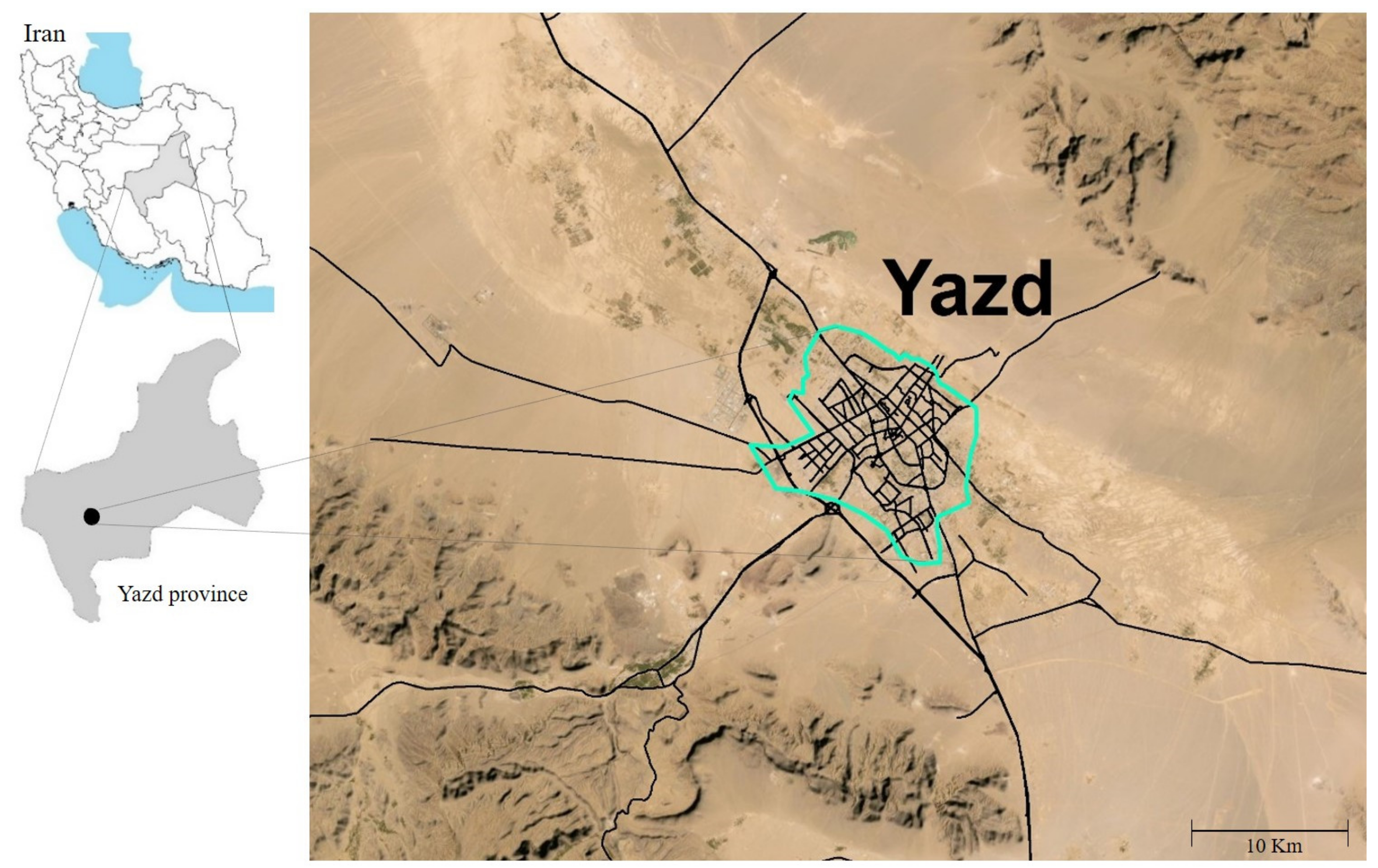
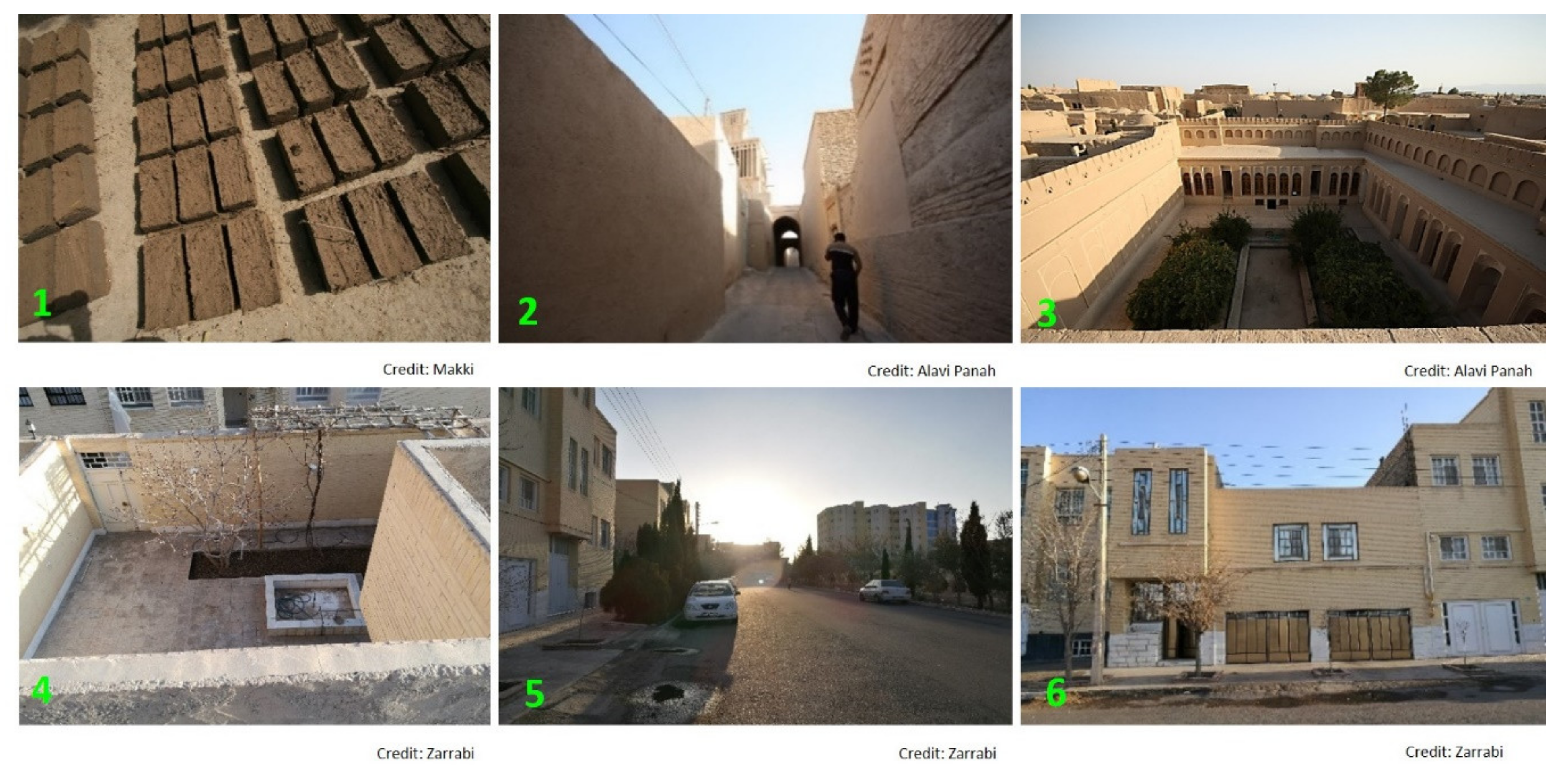
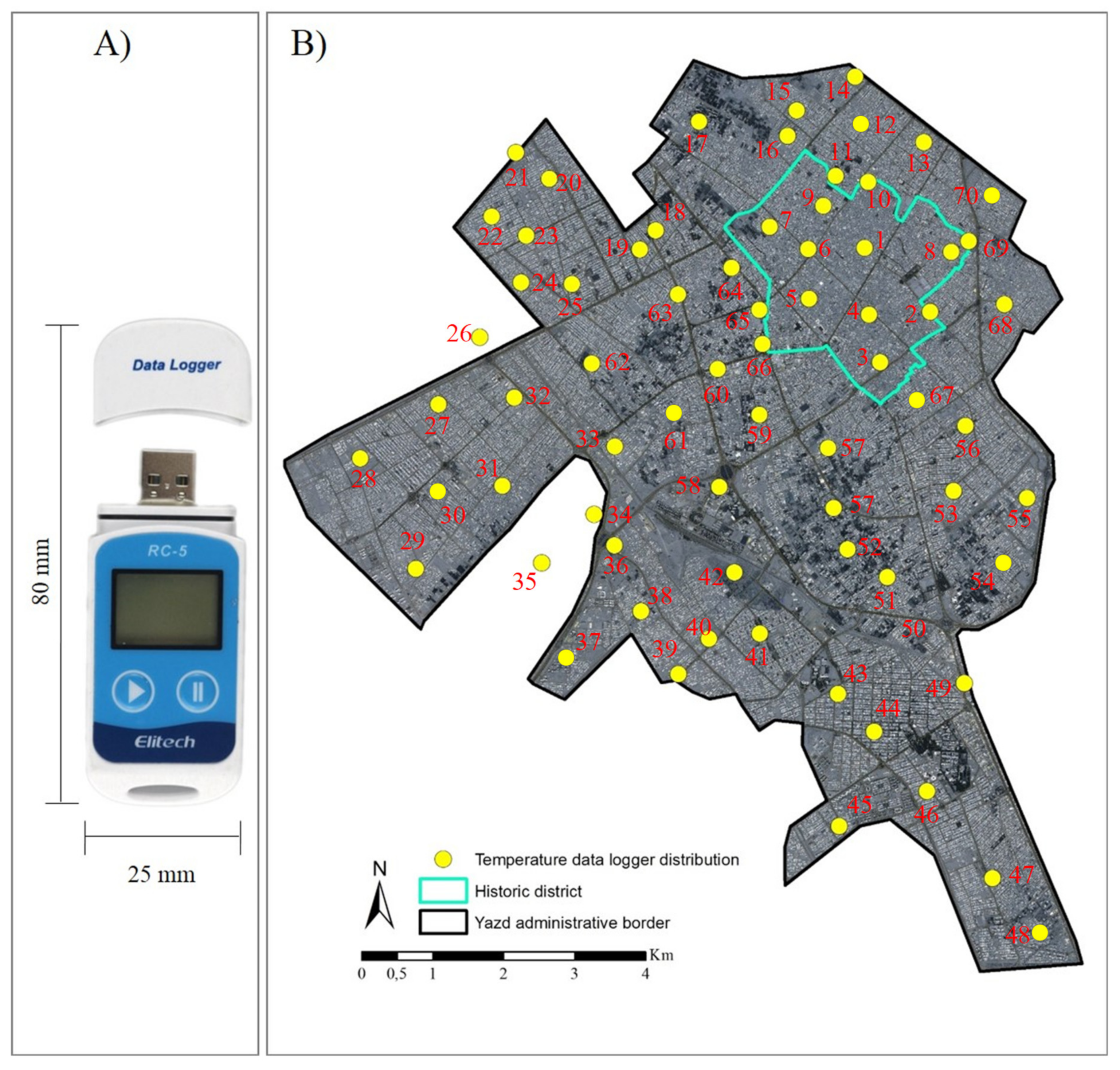
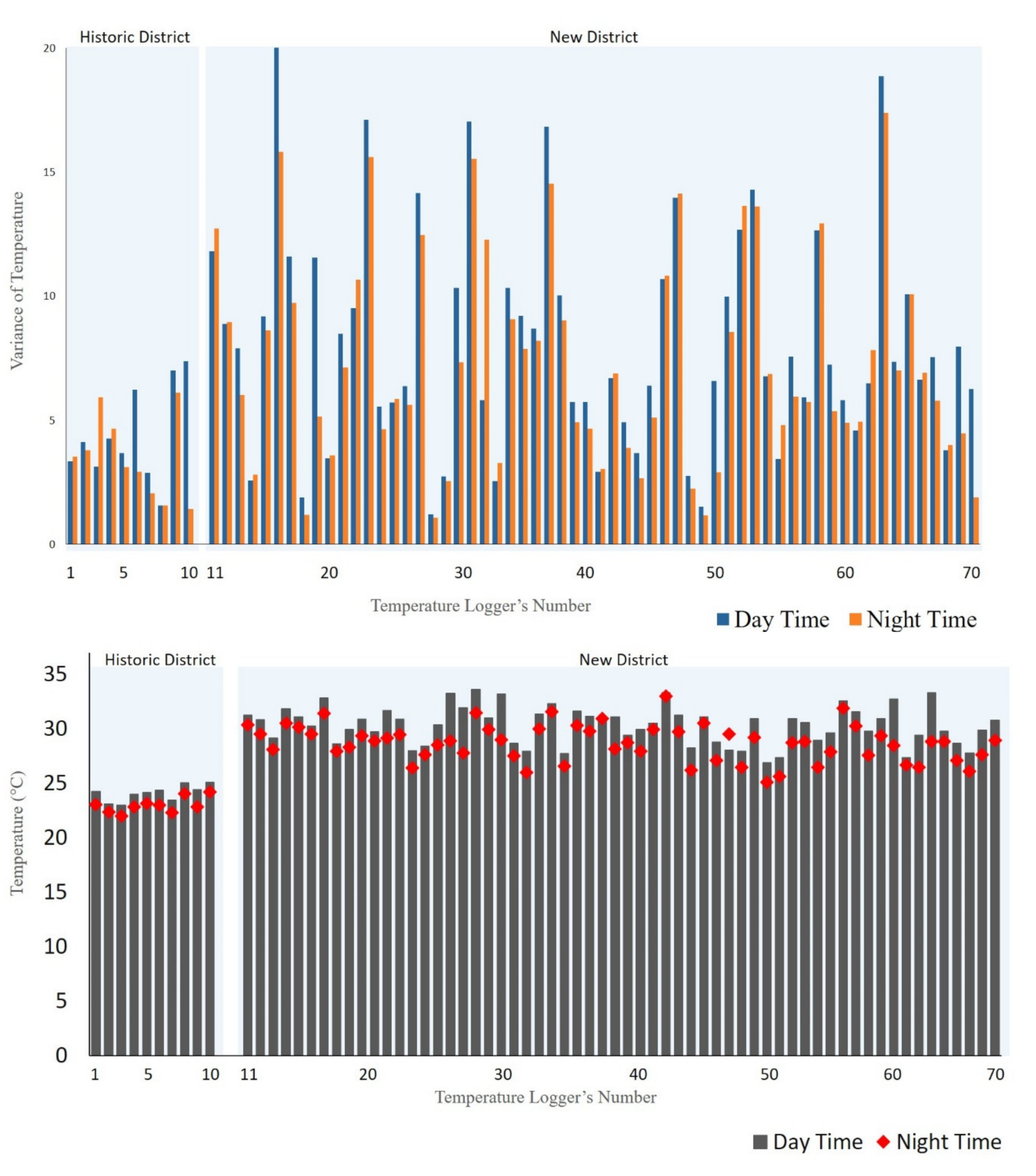

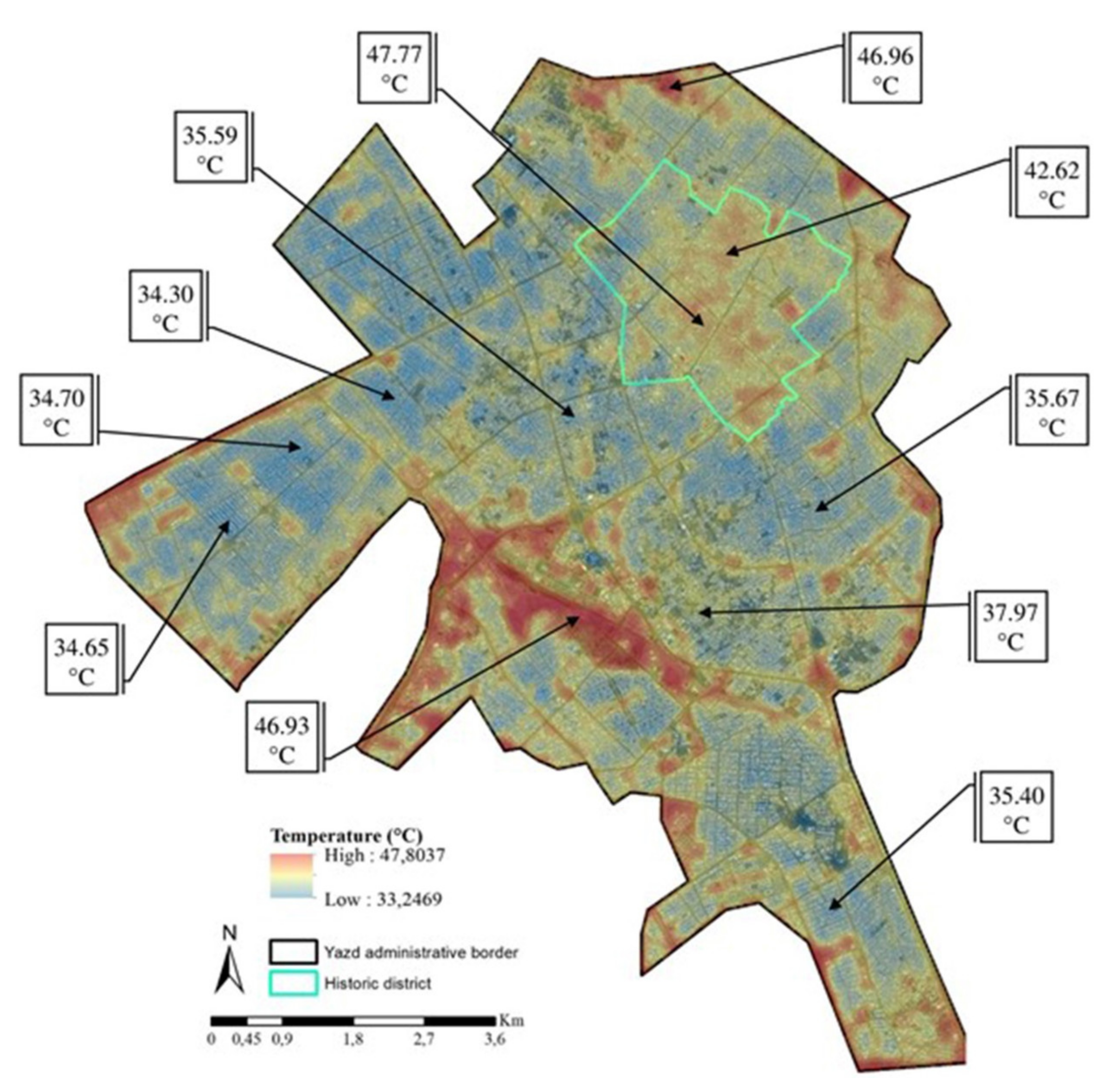
| Months of Temperature Record | Average Sunrise | Average Sunset | Day Length Hours |
|---|---|---|---|
| March | 06:47:30 | 19:08:00 | 11:55:00 |
| April | 06:24:00 | 19:22:00 | 12:55:00 |
| May | 05:56:30 | 19:42:00 | 13:46:00 |
| June | 05:48:30 | 19:57:30 | 14:11:00 |
| July | 05:58:30 | 19:56:00 | 14:00:00 |
| August | 06:17:00 | 19:32:00 | 13:17:00 |
| September | 06:35:00 | 19:33:00 | 12:19:00 |
| Critical Value (z-Score) | Significance Level (p-Value) | Confidence Level |
|---|---|---|
| < −1.65 or > +1.65 | <0.10 | 90% |
| < −1.96 or > +1.96 | <0.05 | 95% |
| < −2.58 or > +2.58 | <0.01 | 99% |
| Surface Temperature | Minimum Record (°C) | Maximum Record (°C) | Average (°C) | Standard Deviation |
|---|---|---|---|---|
| Entire study area | 33.2 | 47.8 | 39.2 | 2.6 |
| Built-up area in new district | 32.2 | 45.2 | 38.2 | 1.9 |
| Built-up area in historical district | 34.4 | 46.9 | 39.2 | 1.7 |
| Bare soil | 37.0 | 47.8 | 42.8 | 1.9 |
Publisher’s Note: MDPI stays neutral with regard to jurisdictional claims in published maps and institutional affiliations. |
© 2021 by the authors. Licensee MDPI, Basel, Switzerland. This article is an open access article distributed under the terms and conditions of the Creative Commons Attribution (CC BY) license (http://creativecommons.org/licenses/by/4.0/).
Share and Cite
Alavipanah, S.; Haase, D.; Makki, M.; Nizamani, M.M.; Qureshi, S. On the Spatial Patterns of Urban Thermal Conditions Using Indoor and Outdoor Temperatures. Remote Sens. 2021, 13, 640. https://doi.org/10.3390/rs13040640
Alavipanah S, Haase D, Makki M, Nizamani MM, Qureshi S. On the Spatial Patterns of Urban Thermal Conditions Using Indoor and Outdoor Temperatures. Remote Sensing. 2021; 13(4):640. https://doi.org/10.3390/rs13040640
Chicago/Turabian StyleAlavipanah, Sadroddin, Dagmar Haase, Mohsen Makki, Mir Muhammad Nizamani, and Salman Qureshi. 2021. "On the Spatial Patterns of Urban Thermal Conditions Using Indoor and Outdoor Temperatures" Remote Sensing 13, no. 4: 640. https://doi.org/10.3390/rs13040640






